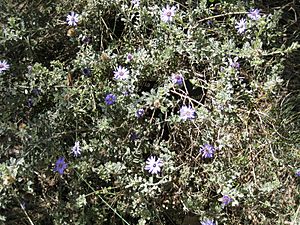Marble daisy-bush facts for kids
Quick facts for kids Marble daisy-bush |
|
|---|---|
 |
|
| Conservation status | |
| Scientific classification | |
| Genus: |
Olearia
|
| Species: |
astroloba
|
| Synonyms | |
|
|
The Olearia astroloba, also known as the Marble daisy-bush, is a special kind of shrub. It is quite rare and belongs to the Asteraceae family, which includes daisies and sunflowers. This plant is only found in the state of Victoria in Australia.
Contents
What Does the Marble Daisy-Bush Look Like?
This shrub usually grows to about 0.5 meters (about 1.6 feet) tall. Its leaves are a grey-green color and are about 18 millimeters (0.7 inches) long and 10 millimeters (0.4 inches) wide.
The Marble daisy-bush has pretty "daisy" flowerheads. These flowers have soft purple petals, called ray florets, and a bright yellow center, made of tiny disc florets. The best time to see these flowers in their natural home is between June and July. However, you might still see some flowers appearing until March.
How Was This Plant Discovered?
Scientists officially named and described the Olearia astroloba in 1989. They published their findings in a science journal called Muelleria. The description was based on plants collected from a place called Marble Gully in 1988. Before it got its official name, people sometimes called it Olearia sp. Nunniong.
Where Does the Marble Daisy-Bush Live?
This unique plant only grows in a specific area called Marble Gully. This area is near Mount Tambo in East Gippsland, Victoria. It likes to grow on thin, rocky soils found on steep hillsides that face north. These spots are usually about 600 meters (about 2,000 feet) above sea level.
Other plants that grow alongside the Marble daisy-bush include the Allocasuarina verticillata, Eucalyptus nortonii, Pomaderris oraria subsp. calcicola, Ozothamnus adnatus, and Themeda triandra.
Protecting the Marble Daisy-Bush
The Olearia astroloba is considered "vulnerable." This means it is at risk of becoming endangered if we don't protect it. It is listed as vulnerable under Australia's Environment Protection and Biodiversity Conservation Act 1999. It is also listed as "threatened" under the Victorian Flora and Fauna Guarantee Act 1988.
Scientists believe there are only about 1,030 of these plants left. They are spread out over an area of about 40 hectares (about 100 acres).
Some things that could harm the Marble daisy-bush population include:
- Fires: Fires that happen too often or at the wrong time can damage the plants.
- Weeds: Invasive weeds can grow and take over the space the daisy-bush needs.
- Grazing: Animals like farm stock and rabbits can eat the plants.
- Mining: Digging for marble in the area could destroy their habitat.
Growing the Marble Daisy-Bush
If you wanted to grow a Marble daisy-bush, it prefers a spot where the water drains well. It likes full sun or a little bit of shade. This plant can handle dry periods and even some moderate frost.
Trimming the plant helps it grow new shoots and produce more flowers. You can grow new plants from cuttings (small pieces of the plant) or from seeds. However, many of the seeds might not be able to grow into new plants.
Images for kids



